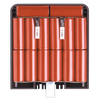What are the types of thermal control devices?
Featured Product from Portage Electric Products, Inc.
There are many different basic types of what is generally classified as thermal control devices. Each type is designed to react to changes in temperature or current to make or break an electrical circuit. In fact, each of these basic types can be expanded into various sub-categories that are used in so many different applications, they are too numerous to mention.
The basic types of thermal controls include:
- Cantilever Bimetallic Devices (Auto. Reset, Self-Hold, and Non-Reset Types)
- Disc-Type Bimetallic Devices (Auto. Reset, Self-Hold, and Manual Reset Type)
- Adjustable Temperature Type Devices
- Solid State & Electronic Type Devices
- Thermal Fuses
Each of these control devices does some things better than others. There are no hard and fast rules and many application factors need to be considered. In many applications multiple thermal controls are used to offer the highest degree of product safety to the consumer. There are some general considerations that determine when certain types of devices are probably your best bet.
Cantilever Bimetallic Devices
Cantilever bimetallic devices, which is the technical term applied to most single element bimetallic type controls, excel at handling electrical loads up to six amps and can operate on currents from millivolts up to 240 VAC. The construction techniques vary widely for these types of thermal controls and the operating characteristics for each type can vary based on the style of construction. There are two basic types of Cantilever controls that include Creep Action and Snap Action type bimetallic controls.
Basically creep action devices get their name from the movement of the bimetallic element used in this construction type. A creep action device utilizes a single bimetal element which either will open or close an electrical circuit based on increases in temperature and or current. The bimetallic element is produced so that there is little or no temperature differential between the opening and closing point of the devices. In certain applications, this produces a narrow temperature operating range which is desirable in many application types.
Snap action devices are similar in function to creep action devices in that snap action devices will open and close an electrical circuit based on increases in either temperature and or current. The real difference is that they are produced with specially formed bimetallic elements which produce a wider temperature variation between the point where the thermal control opens and the point at which the device will close. The devices get their name from the “snapping” sound that the bimetallic element makes when it reacts to changes in temperature.
Disc-Type Bimetallic Devices
Disc-type bimetallic devices get their name from the shape of the bimetallic element that is utilized in these devices. The bimetallic element is generally round in shape and is then specially formed to give it a “disc” like shape. The size of the bimetal discs does vary depending on the construction styles of various manufacturers but disc-type devices generally come in ½” and ¼” disc styles. Since the bimetallic disc is usually electrically isolated from the electrical circuit, these devices are generally more suitable for applications where you need to interrupt resistive current loads of more than six amps.
Adjustable Temperature Control Devices
Adjustable devices are used when there is a need to allow for temperature adjustment in the end application. The size and shape of these devices vary widely based largely on the temperature range that the devices will control and also based on the actual application. These devices include what are commonly referred to as capillary type controls, bulb and capillary type controls, “stack” type or leaf thermostats, and adjustable electronic type controls.
Solid StateThermal Devices
Solid state and Electronic type control devices cover a variety of applications. The products used for these applications can range from individual temperature sensors comprised of various materials all the way to entire circuit boards. In some cases, solid state devices can not only generate heat, but regulate it as well. In general, solid state and or electronic type devices are associated with very precise temperature measurement and control.
Thermal Fuses
Thermal fuses are generally the most cost effective solution for limiting an over-temperature condition in customer applications but are the least versatile type of device as they contain a fuseable link which operates one time and then must be replaced. These devices are commonly referred to as “One-shots” or one time use type control. These devices are good to use either as a back-up device to a resettable type device or when a catastrophic occurrence is possible and you would want the product to totally shut-down.






